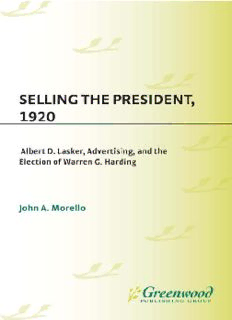
Selling the President, 1920: Albert D. Lasker, Advertising, and the Election of Warren G. Harding PDF
Preview Selling the President, 1920: Albert D. Lasker, Advertising, and the Election of Warren G. Harding
Selling the President, 1920 This page intentionally left blank Selling the President, 1920 Albert D. Lasker, Advertising, and the Election of Warren G. Harding John A. Morello Westport, Connecticut PRAEGER London Library of Congress Cataloging-in-Publication Data Morello, John A., 1951- Selling the president, 1920 : Albert D. Lasker, advertising, and the election of Warren G.Harding / John A. Morello. p. cm. Includes bibliographical references and index. ISBN 0-275-97030-2 (alk. paper) 1. Presidents—United States—Election—1920. 2. Advertising, Political—United States. 3. Lasker, Albert Davis, 1880-1952. I. Title. JK526 2001 324.973,0913—dc21 00-064944 British Library Cataloguing in Publication Data is available. Copyright © 2001 by John A. Morello All rights reserved. No portion of this book may be reproduced, by any process or technique, without the express written consent of the publisher. Library of Congress Catalog Card Number: 00-064944 ISBN: 0-275-97030-2 First published in 2001 Praeger Publishers, 88 Post Road West, Westport, CT 06881 An imprint of Greenwood Publishing Group, Inc. www.praeger.com Printed in the United States of America The paper used in this book complies with the Permanent Paper Standard issued by the National Information Standards Organization (Z39.48-1984). 10 9 8 7 6 5 4 3 21 To Ruth: Your sacrifice made all of this possible. Thank you. This page intentionally left blank Contents Acknowledgments ix Abbreviations xi Introduction 1 1. Season of Change 3 2. Albert Lasker and "Reason Why" Advertising 15 3. Pork, Beans, and Politics 27 4. To Washington, Through Chicago 37 5. Something Old, Something New ... 49 6. Something Borrowed ... 63 7. The Man with the Best Told Story Wins 75 8. November 2, 1920: Closing the Sale 91 Epilogue 99 References 103 Index 109 This page intentionally left blank Acknowledgments It has been said that success has a thousand fathers, but that failure is an orphan. Should this work prove to be a success, then it would be the former and not the latter. I had quite a bit of help bringing this project to paper, and the names of those who helped could quite literally fill a book. Here are just a few. First and always to my wife Ruth, whose belief in me at times exceeded mine and whose sacrifices made mine seem small by comparison. My sister-in-law, Sharon, gave me office space in her home where a good deal of this work was written. She has a garden that proved to be a continuous source of inspiration. Drs. Richard Jensen, Leo Schelbert, and Jerry Danzer, professors at the University of Illinois at Chicago, have all played a role in helping this work take shape, and for that I am in your collective debt. Marianne Berger, Lalu Palamatan, and a legion of reference librarians across the country deserve my thanks for their assistance and their patience. The reference librarians at the Ohio Historical Society and the Indiana State Library were especially helpful in providing critical primary source documents essential to this project. The organizers of the 1999 Ohio Valley History Conference, the 1999 Illinois State History Symposium, and the 2000 Missouri Valley History Conference are all to be thanked for allowing me to present slices of this work to colleagues for their consideration. Their comments have helped to sharpen its focus. Dr. Sandra Graham, Dean of the General Education Department at the DeVry Institute of Technology in Addison, Illinois, has supported this project from its inception and approved my request for a sabbatical. William Hughes, former Dean of Academic Affairs at that same institution, first suggested that I pursue this project, and his successor, Susan Friedberg, Ph.D., has followed in his footsteps. My students at DeVry also deserve a word of thanks. Frequently my class discussions would somehow wander into a discussion of the work I was doing. They didn't seem to mind. They were genuinely interested in what I was doing, and that support kept me going when I found myself stymied either by insufficient research materials, or simply writer's
Description: